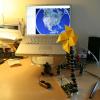Description
As you fly around a Google Earth, the pinwheel spins in proportion to your horizontal speed.
Components
- DC Motor
- Transistor
- Resistor
- Diode
Arduino Code
I reused some code from some of the lab examples in my Arduino code
// serial input vars
char serInString[100];
char cmd;
int motorPin = 9; // select the pin for the Motor
int val;
void setup() {
Serial.begin(9600);
analogWrite(motorPin, 0);
}
void loop() {
readSerialString(serInString, 100);
cmd = serInString[0];
if (cmd == 's') { // if we should spin val = atoi(serInString+1);
analogWrite(motorPin, val);
Serial.print("Spin: "); Serial.println(val);
}
resetSerialString(serInString, 100);
delay(100); // Python does weird things if the lines come in too fast
}
//read a string from the serial and store it in an array
//you must supply the array variable
void readSerialString (char *strArray, int maxLength) { int i = 0;
if(!Serial.available()) {
return;
}
while (Serial.available() && i < maxLength) { strArray[i] = Serial.read();
i++;
}
}
void resetSerialString (char *strArray, int length) {
for (int i = 0; i < length; i++) { strArray[i] = '\0';
}
}
Python Code
Requires the pyserial module for Python (http://pyserial.sourceforge.net) and the appscript module (http://appscript.sourceforge.net) . . . and a computer running OS X. Many thanks to Hannes Hesse for showing me how to control Arduino with Python (my code was partiall lifted from his). I should also point out that this code works fine, but freezes after a few minutes and leaves a process that seems unkillable.
from serial import Serial
from appscript import *
from math import sqrt
def normalize(x):
"""Normalizes x to a value in the 0 to 255 range"""
n = x / 1 * 255
if n > 255: n = 255
if n < 0: n = 0
return n
if __name__ == '__main__':
ser = Serial('/dev/tty.usbserial-A4001nLM', 9600) gearth = app('Google Earth')
viewinfo = gearth.GetViewInfo()
lastx = viewinfo[k.longitude]
lasty = viewinfo[k.latitude]
while 1:
viewinfo = gearth.GetViewInfo()
currx = viewinfo[k.longitude]
curry = viewinfo[k.latitude]
currvelo = sqrt(abs(currx - lastx) + abs(curry - lasty))
print 'current velocity: %d' % currvelo
ser.write('s%d' % normalize(currvelo)) lastx = currx
lasty = curry
ser.close()
Picture
 WindyFlight
WindyFlight


Comments
Comments from TAs
Cool project -- and nice job tying together Google Earth and the Arduino. It would be interesting to combine your project with Jonathan's -- having your fan spin according to the wind speed in whatever location you were currently viewing. Or with Srinivasan's, having a physical globe spin to match the virtual one on Google Earth... Apparently DC motors make people think of spinning globes!